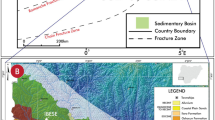Abstract
Observation and experimental analysis of soluble salt deposit along four profiles across the strata deposited in Nihewan paleolake basin enabled us to recognize the nature and evolution stages of the Nihewan paleolake and its significance in stratigraphical division and pa-leo-environmental reconstruction. The Nihewan paleolake was at least a weak-saline to semi-saline lake and represents an intracontinental lake in the semi-arid region. The lower member of sedimentary strata in the paleolake contains gypsum layer and gypsum lamellae. Soluble salt is mainly composed of SO 2-4 and Ca2+ ions, representing a trend of the paleolake evolving into a stage of sulfate lake. The upper member of the strata has predominantly Cl-, K+, and Na+ ions in soluble salt, indicating a starting development of the paleolake to chlorite lake, but no salt rock was deposited, indicating a drying trend of the area.
Similar content being viewed by others
References
Barbour, G. B., Preliminary observations in the Kalgan Area, Bull. Geol. Soc. China, 1924, 3(2): 153.
Barbour, G. B., Licent, E., Teilhard de Chardin, P., Geological study of the deposits of the Sang Kan Ho Basin, Bull. Geol. Soc. China, 1927, 5(3–4): 263.
Teilhard de Chardin, P., Piveteau, J., The mammal fossils of Nihowan (China), Annales de Paleontologie (in French), 1930, 19: 3.
Black, D., Teilhard de Chardin, P., Young, C. C. et al., Fossil man in China, Mon. Geol. Surv. China, Ser. A, 1933, (11): 1.
Young, C. C., The boundary between Pliocene and Pleistocene, Science (in Chinese), 1949, 31(11): 332.
Gai, P., Wei, Q., Discovery of a stone artifact from Lower Pleistocene, Nihowan, Vertebrata Palasiatica (in Chinese), 1974, 12(1): 69.
Chia, L. P., Wei, Q., Li, C. R., Report on the excavation of Hsuchiayao Man Site in 1976, Vertebrata Palasiatica (in Chinese), 1979, 17(4): 288.
You, Y. Z., New materials from Xiaochangliang Paleolithic Site, Hebei Province, and the problem of its date (in Chinese), Prehistoric Research, 1983, (1): 46.
Huang, B. Y., Guo, S. Y., Discussion on stratigraphic division, geological period and palaeography of the Nihewan according to the Mollusca, Bulletin of the Tianjin Institute of Geology and Mineral Resources, Chinese Academy of Geological Sciences (in Chinese), 1981(4): 17.
Cheng, G. L., Lin, J. L., Li, S. L. et al., A preliminary paleomagnetic survey of the Nihewan Bed, Scientia Geologica Sinica (in Chinese), 1978(3): 247.
Li, H. M., Wang, J. D., Magnetostratigraphic study of Nihewan Formation, Annual Reports of Institute of Geochemistry (1982–1983) (in Chinese), Guiyang: Guizhou People’s Publishing House, 1983, 182–184.
Li, R. Q., Yuan, B. Y., Discovery of Pleistocene stromatolites in Nihewan Area, Hebei Province, Scientia Geologica Sinica (in Chinese), 1992, (1): 97.
Xia, Z. K., Zhang, Y., Yang, D. J. et al., Stromatolites discovered in Nihewan Formation and their paleoenvironment, Science in China, Ser. B, 1994, 37(5): 634.
Yuan, B. Y., Zhu, R. X., Tian, W. L. et al., The age, stratigraphic classification and correlation of the Nihewan Formation, Science in China (in Chinese), Ser. D, 1996, 26(1): 67.
Cao, J. X., Neotectonic movements and volcanic activities in the southeast of Datong Basin (Shanxi), China Quaternary Research (in Chinese), 1959, 2(2): 60.
Yang, J. C., Geomorphology and Quaternary geology in the east of Datong Basin, ACTA Scientiarum Naturalium University Pekinensis (in Russian), 1961, 7(1): 87.
Zhou, T. R., Li, H. Z., Liu, Q. S. et al., Cenozoic Palaeogeography of the Nihewan Basin (in Chinese), Beijing: Science Press, 1991, 1–162.
Chen, M. N. (editor-in-chief), Study on the Nihewan Beds (in Chinese), Beijing: China Ocean Press, 1988, 1–145.
Wang, S. M., Yu, Y. S., Wu, R. J. et al., Lake Daihai: Lacustrine Environment and Climatic Changes (in Chinese), Hefei: Publishing House of China University of Science and Technology, 1990, 1–191.
Wang, X., Min, Q. B., Lin, J. X. et al., The discovery of semi-saline foraminiferal fossil faunas from Cenozoic basins in the east of China and their significance, Contribution to Strati-paleontology (in Chinese), 1975(2): 1.
Luckaschev, K. I., Luckaschev, V. K., Geochemistry of Hypergene Zone (translated into Chinese by Zeng Zhiyuan), Beijing: Scientific and Technological Literature Press, 1992, 1–237.
Liu, T. S., Loess and Environment (in Chinese), Beijing: Science Press, 1985, 191–302.
Song, J. S., Wang, X. Y., Geomorphologic analysis of the Sangganhe Gorge at Shixiali in the Nihewan Basin, in Proceedings of the 3rd Symposium on Quaternary in China (in Chinese), Beijing: Science Press, 1982, 311.
Author information
Authors and Affiliations
Corresponding author
Rights and permissions
About this article
Cite this article
Li, R., Qiao, J., Qiu, W. et al. Soluble salt deposit in the Nihewan beds and its environmental significance. Sci. China Ser. D-Earth Sci. 43, 464–479 (2000). https://doi.org/10.1007/BF02875308
Received:
Issue Date:
DOI: https://doi.org/10.1007/BF02875308




